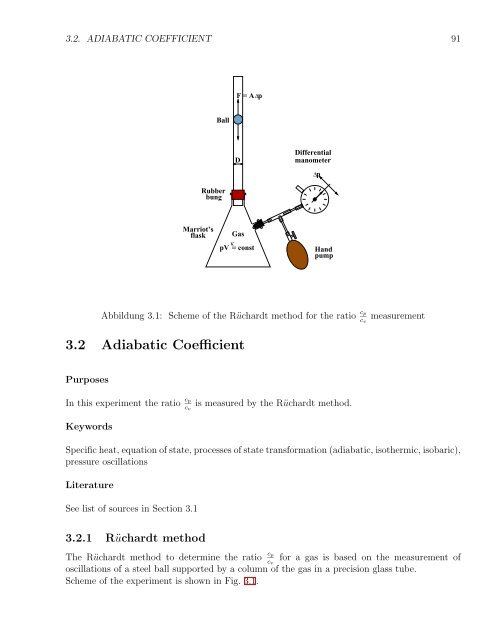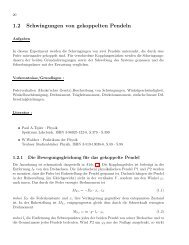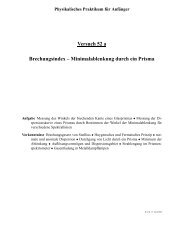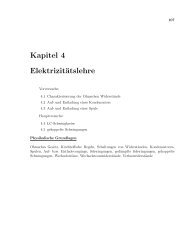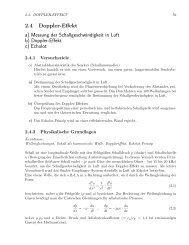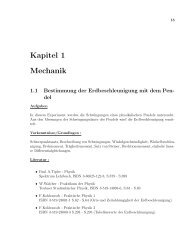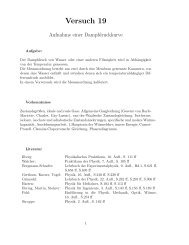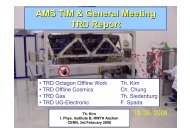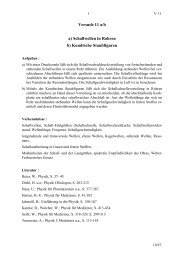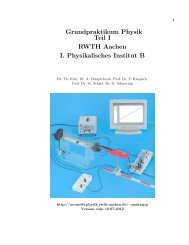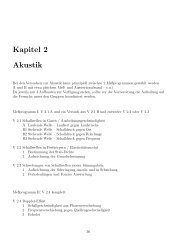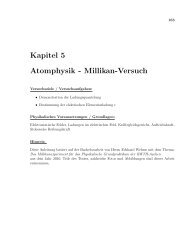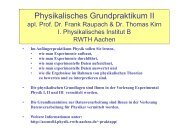3.2 Adiabatic Coefficient
3.2 Adiabatic Coefficient
3.2 Adiabatic Coefficient
Create successful ePaper yourself
Turn your PDF publications into a flip-book with our unique Google optimized e-Paper software.
<strong>3.2</strong>. ADIABATIC COEFFICIENT 91<br />
Rubber<br />
bung<br />
Marriot’s<br />
flask<br />
Ball<br />
F = AΔp<br />
D<br />
Gas<br />
pV κ = const<br />
Differential<br />
manometer<br />
Δp<br />
Hand<br />
pump<br />
Abbildung 3.1: Scheme of the Rüchardt method for the ratio cp<br />
cv measurement<br />
<strong>3.2</strong> <strong>Adiabatic</strong> <strong>Coefficient</strong><br />
Purposes<br />
In this experiment the ratio cp<br />
Keywords<br />
cv<br />
is measured by the Rüchardt method.<br />
Specific heat, equation of state, processes of state transformation (adiabatic, isothermic, isobaric),<br />
pressure oscillations<br />
Literature<br />
See list of sources in Section 3.1<br />
<strong>3.2</strong>.1 Rüchardt method<br />
The Rüchardt method to determine the ratio cp<br />
for a gas is based on the measurement of<br />
cv<br />
oscillations of a steel ball supported by a column of the gas in a precision glass tube.<br />
Scheme of the experiment is shown in Fig. 3.1.
92<br />
The ball fits exactly into the tube having a diameter of about 16 mm. The precision glass tube<br />
is inserted vertically into a glass bottle (Marriot’s flask) which has a rubber stopper with a hole<br />
fitting the glass tube. Gas pressure inside the bottle is measured by a differential manometer.<br />
A hand pump can provide a slow influx of air into the bottle. The increased air pressure raises<br />
the ball along the tube. After air influx is stopped the ball will sink down very slowly. It takes<br />
considerable time to fall through the tube, for the air enclosed in the tube below the ball escapes<br />
very slowly through the narrow gap between ball and tube walls.<br />
If the ball hight is increased sharply by the use of two small permanent magnets the ball starts<br />
to oscillate up and down a few times before continuing to sink down slowly. The oscillations are<br />
damped due to the unavoidable losses of energy by friction. Variations of the air pressure inside<br />
the bottle during these oscillations have to be measured and stored. Analysis of these data in<br />
accordance with a theory described below allows to determine the air adiabatic coefficient κ.<br />
The parameters relevant for the analysis are<br />
• m - mass of the ball<br />
• A = πD 2 /4 - cross-section area of the glass tube<br />
• V - volume of enclosed air<br />
• p0 - atmospheric pressure<br />
• p - pressure inside the bottle<br />
• cp - specific heat at constant pressure<br />
• cv - specific heat at constant volume<br />
• κ = cp<br />
cv<br />
- adiabatic coefficient<br />
The ball is in equilibrium if the pressure p inside the bottle is equal to the sum of the atmospheric<br />
pressure p0 and the pressure due to the weight of the ball:<br />
p = p0 + mg<br />
A<br />
When the ball moves a distance x beyond its equilibrium position, the pressure changes by dp.<br />
By this a force Adp is exerted on the ball. Friction force is proportional to the ball velocity<br />
. Then by Newton’s second law:<br />
Ffr = −αfr dx<br />
dt<br />
m d2x dx<br />
= Adp − αfr<br />
dt2 dt<br />
The process may be considered practically adiabatic. Therefore, according to 3.15 (Section 3.1.1)<br />
By differentiation:<br />
(3.1)<br />
(<strong>3.2</strong>)<br />
pV κ = const (3.3)<br />
V κ dp + pκV κ−1 dV = 0 (3.4)
<strong>3.2</strong>. ADIABATIC COEFFICIENT 93<br />
dp = pκ<br />
dV (3.5)<br />
V<br />
The ball was supposed to move a distance x in the glass tube; this gives a change of volume<br />
By substituting 3.6 in 3.5<br />
dp = − pκAx<br />
V<br />
The equation of motion <strong>3.2</strong> takes now the form<br />
dV = Ax (3.6)<br />
d2x dx pκA2<br />
− αfr + x = 0<br />
dt2 dt mV<br />
(3.8)<br />
This is the differential equation of harmonic oscillations with damping from which the angular<br />
frequency of the ball oscillations can be deduced, which is<br />
<br />
ω =<br />
pκA2 mV<br />
(3.9)<br />
from this follows for κ = cp<br />
cv :<br />
2 mV<br />
κ = ω<br />
pA2 (3.10)<br />
All the quantities on the right side of equation 3.10 are accessible to measurements, therefore κ<br />
can be determined in this way.<br />
<strong>3.2</strong>.2 Setup and Carrying out the Experiment<br />
Apparatus<br />
Oscillation tube;<br />
Stand base, V-shape;<br />
Stand rod, 50 cm;<br />
Clamp with jaw clamp;<br />
Two Marriot’s flasks of different volumes;<br />
Hand vacuum and pressure pump;<br />
Differential pressure sensor;<br />
Absolute pressure sensor;<br />
Sensor-CASSY;<br />
PVC tubes;<br />
Connectors;<br />
Permanent magnets;<br />
Digital balance;<br />
Precision micrometer.<br />
The pressure sensor enables differential pressures ∆p = p1 − p2 between 0 and ±70 hP a to be<br />
measured. It can be connected directly to the Sensor-CASSY.<br />
Technical data:<br />
(3.7)
94<br />
• Measuring ranges: ±0.7 hP a, ±7 hP a, ±70 hP a<br />
• Resolution: 0.05% of measuring range<br />
The technical data of the absolute pressure sensor are described in Section 3.1.2.<br />
Setup<br />
Set up the experiment as shown in Fig.<strong>3.2</strong>:<br />
• Insert the oscillation tube vertically into the dry Marriot’s flask. Both sides of the tube<br />
should be closed to avoid fast movements of the ball inside the tube.<br />
• Fix the vertical position of the tube by clamping it with the jaw clamp connected with the<br />
stand.<br />
• Connect the outlet of the Marriot’s flask with the hand pump and with the differential<br />
pressure sensor using the PVC tubes and T-connector.<br />
• Insert the pressure sensor in the INPUT A channel of the CASSY box.<br />
• Open the upper end of the oscillation tube.<br />
The setup is ready for the oscillation measurements.<br />
Carrying out the experiment<br />
The parameters which define the value of the adiabatic coefficient κ, namely<br />
• ω - the ball oscillation frequency<br />
• A = πD2<br />
4 - cross-section of the tube<br />
• m - mass of the ball<br />
• V - volume of the bottle<br />
• p - gas pressure in the equilibrium state of the ball<br />
have to be measured using the provided tools:<br />
• relative pressure sensor<br />
• absolute pressure sensor<br />
• precise micrometer<br />
• digital balance
<strong>3.2</strong>. ADIABATIC COEFFICIENT 95<br />
Abbildung <strong>3.2</strong>: Experiment setup for measuring the ratio cp<br />
cv
96<br />
The measurement of the parameter V can be performed by weighing of the empty bottle and of<br />
the bottle filled with water. This can be done only after performing the oscillation measurement<br />
because the air inside the Marriot’s flask has to be dry then.<br />
Ball oscillation frequencies for different ball positions (heights) inside the tube have to be measured<br />
for both Marriot’s flasks.<br />
All the measurements have to be done several times. Evaluation of sources and values of systematic<br />
and stochastic errors for all the measured parameters should be presented.<br />
The values of the adiabatic coefficient κ together with its measurement errors should be calculated<br />
using all the measurements done. The resulting κ value measured in the experiment have to be<br />
calculated using either weighted mean or linear regression method (or both).<br />
Analysis of the κ error budget (sources of the dominant errors, possible ways to improve the<br />
experiment performance, etc.) has to be presented.


